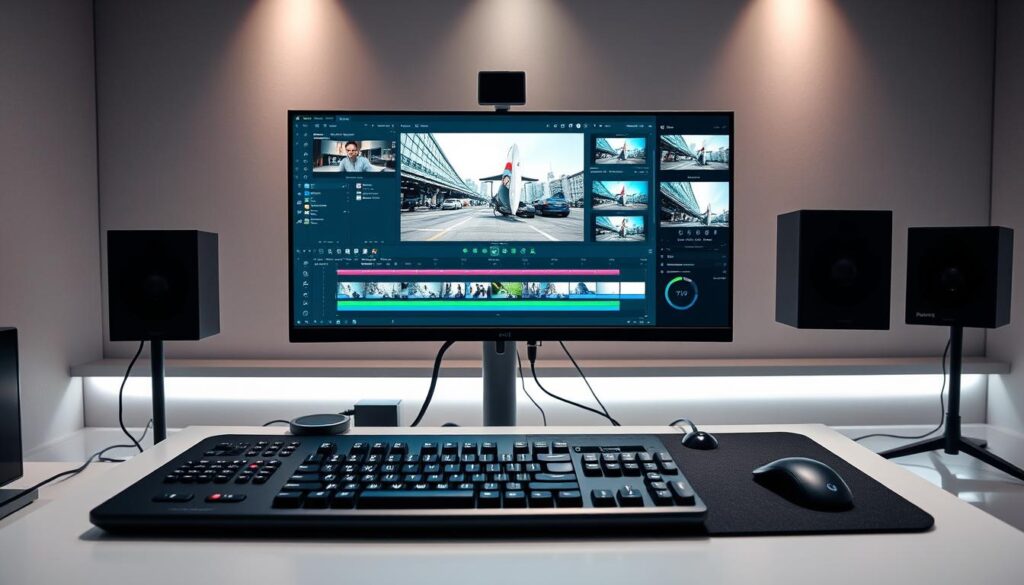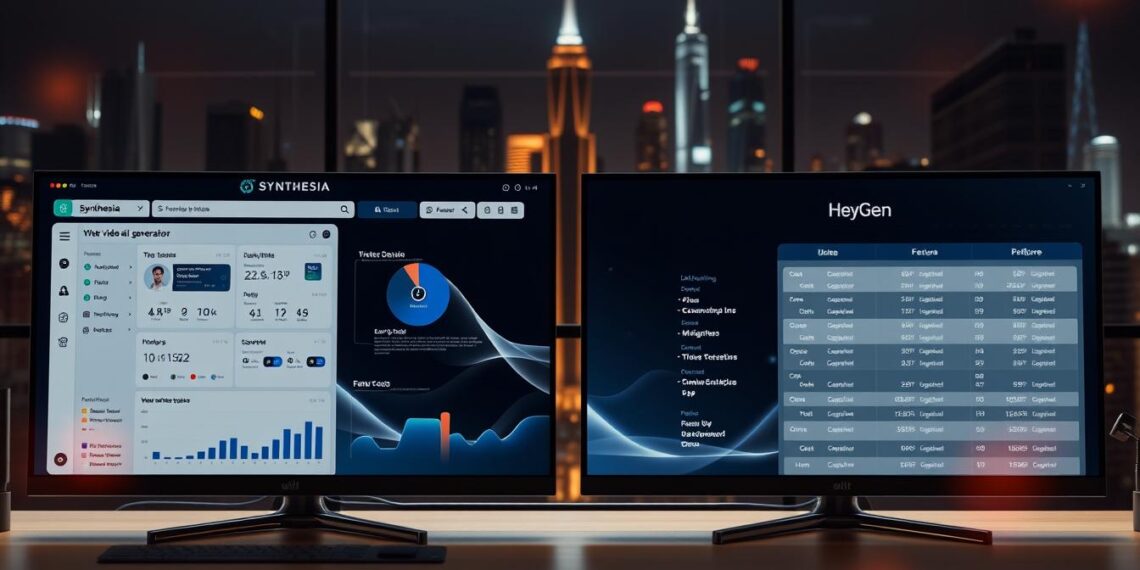Imagine needing to create polished training videos, product demos, or social media clips at scale. Two platforms dominate conversations about AI-driven video generation, but which one truly delivers? While both tools promise efficiency, their approaches differ in ways that could impact your workflow, budget, and creative freedom.
Leading enterprises rely on one platform for its hyper-realistic avatars and seamless integration with existing systems. User reviews consistently praise its ability to handle complex projects while maintaining brand consistency. Meanwhile, newer competitors challenge the status quo with fresh templates and faster rendering speeds.
The real question isn’t just about features – it’s about which solution aligns with your specific content needs. Does superior customization outweigh cost considerations? How do their AI engines handle nuanced voice modulation or industry-specific terminology?
Key Takeaways
- Discover why major companies prefer one platform for enterprise-scale projects
- Compare avatar quality and customization depth between solutions
- Learn how real users rate each tool’s learning curve and output quality
- Understand critical differences in pricing models and support options
- Evaluate which platform excels at specific use cases like training or marketing
Overview of AI Video Generation Platforms
Businesses now generate video content faster than ever, thanks to AI tools that replace cameras and actors. These platforms let you create professional videos using digital avatars and automated scripts. No more scheduling film crews or hunting for studio space – your next explainer video could be ready in minutes.
Introduction to AI Video and Avatar Generators
Modern video creation starts with typing text. AI converts your words into lifelike avatars that speak naturally in 120+ languages. These digital presenters adapt to your brand’s style, wearing custom outfits and matching your tone. Over 65% of companies using this tech report 50% faster content production compared to traditional methods.
How AI Transforms Video Production
Forget editing timelines and voiceover recordings. AI analyzes your script to auto-generate scenes, transitions, and even background music. Marketing teams use these tools to produce localized versions of training materials or product demos simultaneously. Internal communications get sharper with personalized messages from CEO-like avatars.
| Aspect | Traditional Video | AI-Generated Video |
|---|---|---|
| Production Time | 2-3 weeks | Under 1 hour |
| Cost per Minute | $2,500+ | $50-$300 |
| Customization | Limited revisions | Instant changes |
This shift makes video creation accessible to non-designers. Sales teams build client pitches while HR develops onboarding modules – all without technical skills. The key advantage? Scaling content without sacrificing quality or breaking budgets.
In-Depth Look at Synthesia
Modern video creators demand tools that balance creative control with technical simplicity. One platform stands out for its ability to transform text into professional-grade videos while maintaining brand consistency across global teams.
Unique Features and Capabilities
The platform’s extensive avatar library offers over 140 diverse digital presenters, each capable of speaking 120+ languages. What sets it apart? AI that adjusts facial expressions based on your script’s emotional cues. A training video about workplace safety automatically triggers concerned looks, while product launch content generates enthusiastic gestures.
![]()
User Interface and Customization Options
You’ll find drag-and-drop simplicity paired with deep editing tools. Change an avatar’s outfit mid-scene or blend multiple accents within a single video. The timeline editor lets you fine-tune pauses and emphasis points like a studio director.
For brands needing distinct identity, custom avatars replicate team members or create entirely original personas. Real-time collaboration features allow stakeholders worldwide to review and annotate projects simultaneously, slashing approval times by 70% compared to traditional methods.
Exploring HeyGen’s Offerings
Small teams and independent creators often need video tools that balance quality with simplicity. One platform shines here by focusing on lifelike digital presenters and flexible voice options. Its approach helps users craft professional content without complex editing skills.
![]()
Avatar Realism and Voice Cloning
The platform’s realistic avatars display subtle eyebrow raises and authentic lip movements. These digital actors adapt to your script’s tone, whether you’re explaining tax strategies or promoting skateboards. Voice cloning stands out – upload a 30-second sample, and the AI replicates your speech patterns for brand consistency.
Main Use Cases for Creators and Small Businesses
Social media managers love creating snackable clips showing products in action. A bakery owner could film a week’s worth of Instagram Reels in 20 minutes. Marketing teams build localized ads by swapping languages while keeping the same presenter.
Freelancers use these tools to pitch clients with personalized demo videos. The platform offers pre-built templates for common scenarios like explainers or testimonials. For those exploring options, comparing top AI video tools reveals how voice flexibility impacts engagement.
Synthesia vs HeyGen: Core Features Compared
Global teams require video tools that adapt to diverse workflows while maintaining security standards. Both platforms deliver text-to-video magic but take different paths to achieve it. Let’s break down how they handle crucial elements like multilingual support and team collaboration.

Text-to-Video and Language Support
Creating videos using text input works smoothly on both platforms. One converts scripts to video 35% faster with auto-generated scene transitions. The other offers real-time previews during editing for precise timing adjustments.
For language support, you get 120+ options with regional accents. Need a Mexican Spanish avatar instead of Castilian? One platform nails dialects better. The competitor simplifies localization with bulk translation tools for 20+ file formats.
Customization, Security, and Collaboration Tools
Enterprise teams favor granular permissions and version control. Custom pricing plans include SSO authentication and encrypted project vaults. Smaller studios appreciate drag-and-drop template libraries with brand kit integrations.
| Feature | Platform A | Platform B |
|---|---|---|
| Text-to-Video Speed | 2.1 mins render time | 3.4 mins render time |
| Supported Languages | 125 with accent control | 140+ with auto-translate |
| Custom Avatars | $1,000+ per model | Included in Pro plans |
| Team Features | Unlimited reviewers | 5 collaborators max |
Pricing transparency varies widely. Monthly subscriptions start at $29 for basic features. Custom pricing becomes essential for enterprises needing API access or priority support – expect quotes over $15k/year.
Detailed Feature Analysis for Both Platforms
Choosing between leading AI video platforms requires peeling back layers of features to see what truly impacts your workflow. Let’s examine how avatar expressions and editing capabilities shape your creative process.

Avatar Customization and Realistic Expressions
One platform uses emotional AI to sync eyebrow movements with script keywords like “urgent” or “exciting.” Avatars blink naturally and adjust head tilts based on sentence structure. The competitor focuses on hand gestures – 18 preset motions that match industries from healthcare to real estate.
Customization depth varies. You can tweak skin tones and hairstyles on both platforms, but only one lets you design outfits layer-by-layer. Enterprise teams often prefer the tool offering micro-expression controls for sensitive training content.
Editing Tools and Video Template Libraries
Your editing experience depends on project complexity. Beginners love drag-and-drop templates with auto-generated captions. Power users value timeline splitting and multi-track audio syncing.
- Platform A: 300+ industry-specific templates with brand color locking
- Platform B: Template mixer for combining intros/outros from different styles
Collaboration features differ sharply. One system allows 10+ simultaneous editors with change tracking. The other limits teams to 3 users but offers better version history visualization.
| Feature | Option 1 | Option 2 |
|---|---|---|
| Interface Type | Node-based editor | Linear timeline |
| Templates | Updated weekly | User-submitted library |
| Collaboration | Real-time comments | Approval workflows |
| Updates | Automatic AI improvements | Manual plugin system |
For quick-turn video projects, template-driven platforms save hours. Those needing unique animations might prefer tools with advanced keyframing. Test both free tiers to see which editing style matches your team’s rhythm.
Pricing and Value Considerations
Budgeting for AI video tools requires matching your output needs with the right payment structure. Both platforms offer tiered plans catering to different users – from solopreneurs to global corporations. Let’s break down how their pricing models stack up.
Subscription Models and Accessibility
Entry-level free plans let you test basic features with watermarked videos. Paid tiers start at $29 per month, offering 30-45 video minutes monthly. Mid-range options ($67/month) unlock HD exports and custom branding.
Enterprise solutions prioritize scalability. Annual contracts provide unlimited projects and priority rendering. Some include AI voice cloning for consistent brand narration across regions.
Scaling Costs Without Sacrificing Quality
Solo creators save most with pay-as-you-go plans – perfect for sporadic projects. Teams benefit from shared workspaces in premium tiers, splitting costs across members. One platform charges $2.80 per rendered minute after exceeding monthly limits.
| Feature | Starter Plan | Pro Plan | Enterprise |
|---|---|---|---|
| Price/month | $29 | $149 | Custom |
| Video minutes | 30 | 180 | Unlimited |
| Team seats | 1 | 3 | 25+ |
| Support | Live chat | Dedicated manager |
Freelancers report saving $1,200/year compared to stock video subscriptions. Larger firms optimize budgets by centralizing video production – one automotive brand cut costs by 43% per month using bulk rendering credits.
Pros and Cons of Synthesia vs HeyGen
Evaluating AI video tools requires balancing glowing reviews with real limitations. Users praise both platforms for transforming text into engaging videos, but their strengths cater to different content creation needs. Let’s explore what actual creators say about these solutions.
What Users Love Most
Many appreciate one platform’s natural-sounding voiceovers that handle technical jargon flawlessly. “The AI captures vocal inflections better than some human narrators,” notes a cybersecurity training developer. Others highlight seamless collaboration tools that let global teams edit scripts simultaneously.
The competitor wins points for quick-turn projects. Social media managers report producing 15-20 TikTok clips daily using pre-built templates. Custom avatar options receive praise, though some users wish for more diverse body types.
Common Pain Points and Workarounds
Render times frustrate creators needing last-minute changes. One user notes: “Exporting 4K videos takes twice as long during peak hours.” Others mention limited control over background animations compared to traditional editing software.
While both tools simplify video creation, some teams struggle with API integration costs. A marketing director shares: “We built custom Zapier connectors to bridge the gap with our CRM system.”
| Feature | Strength | Limitation |
|---|---|---|
| Avatar Realism | Micro-expression controls | Limited gesture variety |
| Editing Tools | Multi-track audio sync | Basic transition effects |
| Language Support | 140+ dialects | Accent inconsistencies |
| Support | 24/7 live chat | Slow bug resolution |
For teams weighing options, comparing top platforms reveals crucial differences in handling complex projects. Your choice ultimately depends on whether priority lies in cinematic quality or rapid production cycles.
Customer Support and Integration Capabilities
Creating videos at scale demands more than slick features – it requires reliable help when glitches strike and tools that mesh with your existing stack. Let’s examine how top platforms keep your production pipeline flowing smoothly through robust support and smart integrations.
Support Quality and User Resources
One platform offers 24/7 live chat with under 3-minute response times during business hours. Their knowledge base includes video tutorials for every feature, plus troubleshooting guides for common rendering issues. Users report 85% problem resolution on first contact.
The competitor provides tiered support – basic plan users get email responses within 24 hours, while enterprise clients access dedicated Slack channels. Both platforms host weekly webinars covering advanced engagement techniques and template customization.
Platform Integrations and Workflow Efficiency
Seamless connections with popular tools supercharge your generator’s potential. One system integrates directly with Canva for instant asset imports and Zapier for 500+ app automations. Marketing teams sync videos to HubSpot campaigns in three clicks.
- LMS compatibility: SCORM packages for corporate training portals
- Social media auto-posting: Schedule TikTok/Instagram clips natively
- Cloud storage sync: Dropbox & Google Drive version control
Need hands-on help? Some creators pair these tools with professional video editing services for complex projects. Multilingual teams benefit from real-time translation APIs that handle 40+ languages, ensuring global message consistency.
| Feature | Platform X | Platform Y |
|---|---|---|
| Support Channels | Chat/Email/Phone | Email/Slack |
| Integration Count | 220+ | 150+ |
| API Access | All plans | Enterprise only |
| Learning Resources | Interactive courses | PDF guides |
Applications and Use Case Scenarios
AI video tools now power content strategies across industries, solving critical communication challenges. Whether training global teams or engaging customers, these platforms adapt to diverse needs while cutting production timelines.
Corporate Training and E-Learning
Companies use AI-generated videos to onboard employees 60% faster. You can create interactive modules showing safety protocols or software tutorials. One healthcare provider reduced training costs by 42% using custom avatars that demonstrate medical procedures.
E-learning platforms benefit from automated translations. A single cybersecurity course becomes accessible in 12 languages overnight. “Our completion rates jumped 31% after switching to video-based lessons,” shares an L&D manager at a Fortune 500 firm.
Marketing and Social Media Impact
Marketers craft snackable content that converts. Users create TikTok demos showing products from multiple angles – no filming required. Real estate agents produce neighborhood tours with AI narrators highlighting local amenities.
These tools excel at A/B testing ad variations. Swap backgrounds or voices in minutes to see what resonates. Social teams repurpose webinars into 15-second reels, boosting engagement by up to 70%.
| Industry | Use Case | Result |
|---|---|---|
| Retail | Product launch videos | 22% higher click-throughs |
| Education | Language learning series | 3x course completions |
| Healthcare | Patient education clips | 39% fewer support calls |
| Tech | Software walkthroughs | 50% faster onboarding |
Creating videos with AI lets teams focus on strategy over production logistics. From HR handbooks to Instagram Stories, these tools handle repetitive tasks while you refine your message.
Future Trends in AI Video Generation
AI video tools are evolving faster than most teams can adapt. What seemed cutting-edge last year now feels basic. Industry leaders predict radical changes in how we produce and consume digital content.
What’s Coming Next?
Expect platforms to offer interactive video branching within 18 months. Viewers could choose avatar responses during training simulations or product demos. This turns passive watching into engaging experiences.
Three key advancements will reshape workflows:
- Real-time editing: Adjust scripts mid-render without restarting projects
- Dynamic pricing plans: Pay-per-second models for short-form content
- AI directors: Auto-optimize video length based on platform algorithms
Render times for minutes video outputs will drop below 60 seconds as processors improve. Some services may offer truly unlimited videos through cloud-based rendering farms. Imagine creating 500 personalized sales pitches in one click.
Upcoming unique features include emotion-aware voice modulation and background generation from text prompts. Need a Tokyo street scene at sunset? Type it – no stock footage required.
| Current Limits | 2025 Projections |
|---|---|
| Fixed templates | AI-generated scene layouts |
| Manual translations | Real-time dialect matching |
| Basic gestures | Full-body motion capture |
The next wave of AI video tech could slash production costs by 70% while boosting engagement metrics.
Conclusion
Choosing the right AI video platform shapes your content strategy for the entire year. While both solutions deliver professional results, their strengths cater to different creative workflows and budget ranges. One excels in enterprise-grade security and multilingual support, while the other offers rapid prototyping for time-sensitive campaigns.
Your ideal plan depends on three factors: production scale, customization needs, and team collaboration requirements. Brands needing consistent global messaging benefit from advanced translation tools. Startups often prioritize flexible pricing and quick-turn templates.
For a detailed breakdown of features and use cases, explore our comprehensive platform comparison. This resource helps you match specific project goals with each tool’s capabilities – whether creating training modules or social media ads.
As AI video tech evolves, selecting a platform with scalable infrastructure ensures long-term success. Test free tiers, analyze output quality, and consider how each solution supports your growth over the next three years. The right choice today becomes your competitive edge tomorrow.
FAQ
Which platform offers a free trial or plan?
HeyGen provides a free plan with limited features, while Synthesia requires a paid subscription starting at /month. Both tools offer custom pricing for enterprise needs.
Can you create custom avatars for videos?
Yes. Synthesia allows customization of avatars and gestures, while HeyGen focuses on realistic expressions and voice cloning for enhanced personalization.
How many languages do these tools support?
Synthesia supports over 120 languages, making it ideal for global teams. HeyGen offers fewer language options but emphasizes localized voice tones for better engagement.
Which platform is better for social media content?
HeyGen’s quick-turnaround templates suit short marketing clips, while Synthesia excels in longer e-learning or training videos with advanced editing tools.
Do they include collaboration features for teams?
Synthesia provides built-in collaboration tools and secure sharing, whereas HeyGen focuses on solo creator workflows with simpler project management.
Are there limits on video length per month?
Entry-tier plans include capped minutes (e.g., 30–180 minutes/month). Higher tiers or custom plans offer expanded limits for large-scale projects.
Can enterprises get tailored pricing plans?
Both platforms offer custom pricing for enterprises, with bulk discounts and dedicated support for frequent video production needs.
What future updates are expected for these tools?
Enhanced AI avatars, real-time editing, and improved multilingual support are trends to watch, aiming to reduce manual input and boost creativity.




